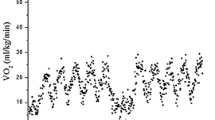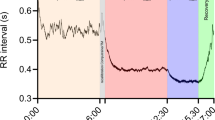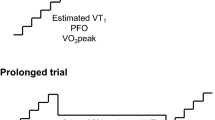Abstract
Purpose
There is some evidence that measures of acute post-exercise recovery are sensitive to the homeostatic stress of the preceding exercise and these measurements warrant further investigation as possible markers of training load. The current study investigated which of four different measures of metabolic and autonomic recovery was most sensitive to changes in exercise intensity.
Methods
Thirty-eight moderately trained runners completed 20-min bouts of treadmill exercise at 60, 70 and 80 % of maximal oxygen uptake (VO2max) and four different recovery measurements were determined: the magnitude of excess post-exercise oxygen consumption (EPOCMAG), the time constant of the oxygen consumption recovery curve (EPOCτ), heart rate recovery within 1 min (HRR60s) and the time constant of the heart rate recovery curve (HRRτ) .
Results
Despite significant differences in exercise parameters at each exercise intensity, only EPOCMAG showed significantly slower recovery with each increase in exercise intensity at the group level and in the majority of individuals. EPOCτ was significantly slower at 70 and 80 % of VO2max vs. 60 % VO2max and HRRτ was only significantly slower when comparing the 80 vs. 60 % VO2max exercise bouts. In contrast, HRR60s reflected faster recovery at 70 and 80 % of VO2max than at 60 % VO2max.
Conclusion
Of the four recovery measurements investigated, EPOCMAG was the most sensitive to changes in exercise intensity and shows potential to reflect changes in the homeostatic stress of exercise at the group and individual level. Determining EPOCMAG may help to interpret the homeostatic stress of laboratory-based research trials or training sessions.


Similar content being viewed by others

Abbreviations
- CVTEM :
-
Typical error as a coefficient of variation
- EE:
-
Energy expenditure
- EPOC:
-
Excess post-exercise oxygen consumption
- EPOCMAG :
-
Magnitude of excess post-exercise oxygen consumption
- EPOCτ:
-
Time constant of oxygen consumption recovery curve
- HR:
-
Heart rate
- HRR:
-
Heart rate recovery
- HRR60s :
-
1-min heart rate recovery
- HRRτ:
-
Time constant of the heart rate recovery curve
- HRmax :
-
Maximal heart rate
- RER:
-
Respiratory exchange ratio
- RPE:
-
Rating of perceived exertion
- PTRS:
-
Peak treadmill running speed
- VO2 :
-
Oxygen uptake
- VO2max :
-
Maximum oxygen uptake
References
Al Haddad H, Laursen PB, Chollet D, Ahmaidi S, Buchheit M (2011) Reliability of resting and postexercise heart rate measures. Int J Sports Med 32:598–605
American College of Sports Medicine (2006) Physical activity readiness questionnaire (PAR-Q). In: Whaley MH, Brubaker PH, Otto RM (eds) ACSM’s guidelines for exercise testing and prescription, 7th edn. Lippincott Williams & Wilkins, Baltimore, p 26
Baar K (2009) The signaling underlying FITness. Appl Physiol Nutr Metab 34:411–419
Bahr R (1992) Excess postexercise oxygen consumption-magnitude, mechanisms and practical implications. Acta Physiol Scand Suppl 605:1–70
Banister EW, Calvert TW (1980) Planning for future performance: implications for long term training. Can J Appl Sport Sci 5:170–176
Borg GA (1970) Perceived exertion as an indicator of somatic stress. Scand J Rehabil Med 2:92–98
Borresen J, Lambert MI (2009) The quantification of training load, the training response and the effect on performance. Sports Med 39:779–795
Bosquet L, Gamelin F-X, Berthoin S (2008) Reliability of postexercise heart rate recovery. Int J Sports Med 29:238–243
Buchheit M, Laursen PB, Ahmaidi S (2007a) Parasympathetic reactivation after repeated sprint exercise. Am J Physiol Heart Circ Physiol 293:H133–H141
Buchheit M, Papelier Y, Laursen PB, Ahmaidi S (2007b) Noninvasive assessment of cardiac parasympathetic function: postexercise heart rate recovery or heart rate variability? Am J Physiol Heart Circ Physiol 293:H8–H10
Campos EZ, Bastos FN, Papoti M, Freitas IF Jr, Gobatto CA, Balikian P Jr (2012) The effects of physical fitness and body composition on oxygen consumption and heart rate recovery after high-intensity exercise. Int J Sports Med 33:621–626
Cohen J (1988) Statistical power analysis for behavioural sciences, 2nd edn. Lawrence Erlbaum Associates, Hillsdale
Daanen HAM, Lamberts RP, Kallen VL, Jin A, Van Meeteren N (2012) A systematic review on heart-rate recovery to monitor changes in training status in athletes. Int J Sports Physiol Perform 7:251–260
Faisal A, Beavers KR, Robertson AD, Hughson RL (2009) Prior moderate and heavy exercise accelerate oxygen uptake and cardiac output kinetics in endurance athletes. J Appl Physiol 106:1553–1563
Flück M (2006) Functional, structural and molecular plasticity of mammalian skeletal muscle in response to exercise stimuli. J Exp Biol 209:2239–2248
Foster C (1998) Monitoring training in athletes with reference to overtraining syndrome. Med Sci Sports Exerc 30:1164–1168
Frey GC, Byrnes WC, Mazzeo RS (1993) Factors influencing excess postexercise oxygen consumption in trained and untrained women. Metabolism 42:822–828
Gaesser GA, Brooks GA (1984) Metabolic bases of excess post-exercise oxygen consumption: a review. Med Sci Sports Exerc 16:29–43
Gerbino A, Ward SA, Whipp BJ (1996) Effects of prior exercise on pulmonary gas-exchange kinetics during high-intensity exercise in humans. J Appl Physiol 80:99–107
Goldberger JJ, Le FK, Lahiri M, Kannankeril PJ, Ng J, Kadish AH (2006) Assessment of parasympathetic reactivation after exercise. Am J Physiol Heart Circ Physiol 290:H2446–H2452
Gore CJ, Withers RT (1990) Effect of exercise intensity and duration on postexercise metabolism. J Appl Physiol 68:2362–2368
Gurd BJ, Scheuermann BW, Paterson DH, Kowalchuk JM (2005) Prior heavy-intensity exercise speeds VO2 kinetics during moderate-intensity exercise in young adults. J Appl Physiol 98:1371–1378
Hagberg JM, Hickson RC, Ehsani AA, Holloszy JO (1980) Faster adjustment to and recovery from submaximal exercise in the trained state. J Appl Physiol 48:218–224
Imai K, Sato H, Hori M, Kusuoka H, Ozaki H, Yokoyama H, Kamada T (1994) Vagally mediated heart rate recovery after exercise is accelerated in athletes but blunted in patients with chronic heart failure. J Am Coll Cardiol 24:1529–1535
Jacobsen DJ, Bailey BW, LeCheminant JD, Hill JO, Mayo MS, Donnelly JE (2005) A comparison of three methods of analyzing post-exercise oxygen consumption. Int J Sports Med 26:34–38
Jones AM, Grassi B, Christensen PM, Krustrup P, Bangsbo J, Poole DC (2011) Slow component of VO2 kinetics: mechanistic bases and practical applications. Med Sci Sports Exerc 43:2046–2062
Kaikkonen P, Nummela A, Rusko H (2007) Heart rate variability dynamics during early recovery after different endurance exercises. Eur J Appl Physiol 102:79–86
Kaikkonen P, Rusko H, Martinmäki K (2008) Post-exercise heart rate variability of endurance athletes after different high-intensity exercise interventions. Scand J Med Sci Sports 18:511–519
Kaikkonen P, Hynynen E, Mann T, Rusko H, Nummela A (2010) Can HRV be used to evaluate training load in constant load exercises? Eur J Appl Physiol 108:435–442
Kaikkonen P, Hynynen E, Mann T, Rusko H, Nummela A (2012) Heart rate variability is related to training load variables in interval running exercises. Eur J Appl Physiol 112:829–838
Kannankeril PJ, Le FK, Kadish AH, Goldberger JJ (2004) Parasympathetic effects on heart rate recovery after exercise. J Investig Med 52:394–401
Krustrup P, Jones AM, Wilkerson DP, Calbet JA, Bangsbo J (2009) Muscular and pulmonary O2 uptake kinetics during moderate- and high-intensity sub-maximal knee-extensor exercise in humans. J Physiol 587:1843–1856
LaForgia J, Withers RT, Gore CJ (2006) Effects of exercise intensity and duration on the excess post-exercise oxygen consumption. J Sports Sci 24:1247–1264
Lambert MI, Borresen J (2010) Measuring training load in sports. Int J Sports Physiol Perform 5:406–411
Lamberts RP, Lambert MI (2009) Day-to-day variation in heart rate at different levels of submaximal exertion: implications for monitoring training. J Strength Cond Res 23:1005–1010
Lamberts RP, Maskell S, Borresen J, Lambert MI (2011) Adapting workload improves the measurement of heart rate recovery. Int J Sports Med 32:698–702
Macfarlane DJ (2001) Automated metabolic gas analysis systems: a review. Sports Med 31:841–861
Mann T, Lamberts RP, Lambert MI (2013) Methods of prescribing relative exercise intensity: physiological and practical considerations. Sports Med 43:613–625
Martinmäki K, Rusko H (2008) Time-frequency analysis of heart rate variability during immediate recovery from low and high intensity exercise. Eur J Appl Physiol 102:353–360
Ng J, Sundaram S, Kadish AH, Goldberger JJ (2009) Autonomic effects on the spectral analysis of heart rate variability after exercise. Am J Physiol Heart Circ Physiol 297:H1421–H1428
Noakes TD, Myburgh KH, Schall R (1990) Peak treadmill running velocity during the VO2 max test predicts running performance. J Sports Sci 8:35–45
Ozyener F, Rossiter HB, Ward SA, Whipp BJ (2001) Influence of exercise intensity on the on- and off-transient kinetics of pulmonary oxygen uptake in humans. J Physiol 533:891–902
Parekh A, Lee CM (2005) Heart rate variability after isocaloric exercise bouts of different intensities. Med Sci Sports Exerc 37:599–605
Perini R, Orizio C, Comandè A, Castellano M, Beschi M, Veicsteinas A (1989) Plasma norepinephrine and heart rate dynamics during recovery from submaximal exercise in man. Eur J Appl Physiol Occup Physiol 58:879–883
Perrey S, Scott J, Mourot L, Rouillon J (2003) Cardiovascular and oxygen uptake kinetics during sequential heavy cycling exercises. Can J Appl Physiol 28:283–298
Reilly T, Brooks GA (1990) Selective persistence of circadian rhythms in physiological responses to exercise. Chronobiol Int 7:59–67
Rietjens GJ, Kuipers H, Kester AD, Keizer HA (2001) Validation of a computerized metabolic measurement system (Oxycon-Pro) during low and high intensity exercise. Int J Sports Med 22:291–294
Rossiter HB, Ward SA, Kowalchuk JM, Howe FA, Griffiths JR, Whipp BJ (2002) Dynamic asymmetry of phosphocreatine concentration and O(2) uptake between the on- and off-transients of moderate- and high-intensity exercise in humans. J Physiol 541:991–1002
Scharhag-Rosenberger F, Carlsohn A, Cassel M, Mayer F, Scharhag J (2011) How to test maximal oxygen uptake: a study on timing and testing procedure of a supramaximal verification test. Appl Physiol Nutr Metab 36:153–160
Scherr J, Wolfarth B, Christle JW, Pressler A, Wagenpfeil S, Halle M (2013) Associations between Borg’s rating of perceived exertion and physiological measures of exercise intensity. Eur J Appl Physiol 113:147–155
Sedlock DA, Lee M-G, Flynn MG, Park KS, Kamimori GH (2010) Excess postexercise oxygen consumption after aerobic exercise training. Int J Sport Nutr Exerc Metab 20:336–349
Seiler S, Haugen O, Kuffel E (2007) Autonomic recovery after exercise in trained athletes: intensity and duration effects. Med Sci Sports Exerc 39:1366–1373
Short KR, Sedlock DA (1997) Excess postexercise oxygen consumption and recovery rate in trained and untrained subjects. J Appl Physiol 83:153–159
Smith J, Mc Naughton L (1993) The effects of intensity of exercise on excess postexercise oxygen consumption and energy expenditure in moderately trained men and women. Eur J Appl Physiol Occup Physiol 67:420–425
Swart J, Jennings C (2004) Use of blood lactate concentration as a marker of training. S Afr J Sports Med 16:1–5
Weir J (1949) New methods for calculating metabolic rate with special reference to protein metabolism. J Physiol 109:1–9
Acknowledgments
This research was supported financially by the Deutscher Akademischer Austausch Dienst (DAAD), the Ernst and Ethel Eriksen Trust and the University of Cape Town.
Conflict of interest
The authors declare that there was no conflict of interest in the preparation of this review.
Author information
Authors and Affiliations
Corresponding author
Additional information
Communicated by Massimo Pagani.
Rights and permissions
About this article
Cite this article
Mann, T.N., Webster, C., Lamberts, R.P. et al. Effect of exercise intensity on post-exercise oxygen consumption and heart rate recovery. Eur J Appl Physiol 114, 1809–1820 (2014). https://doi.org/10.1007/s00421-014-2907-9
Received:
Accepted:
Published:
Issue Date:
DOI: https://doi.org/10.1007/s00421-014-2907-9



